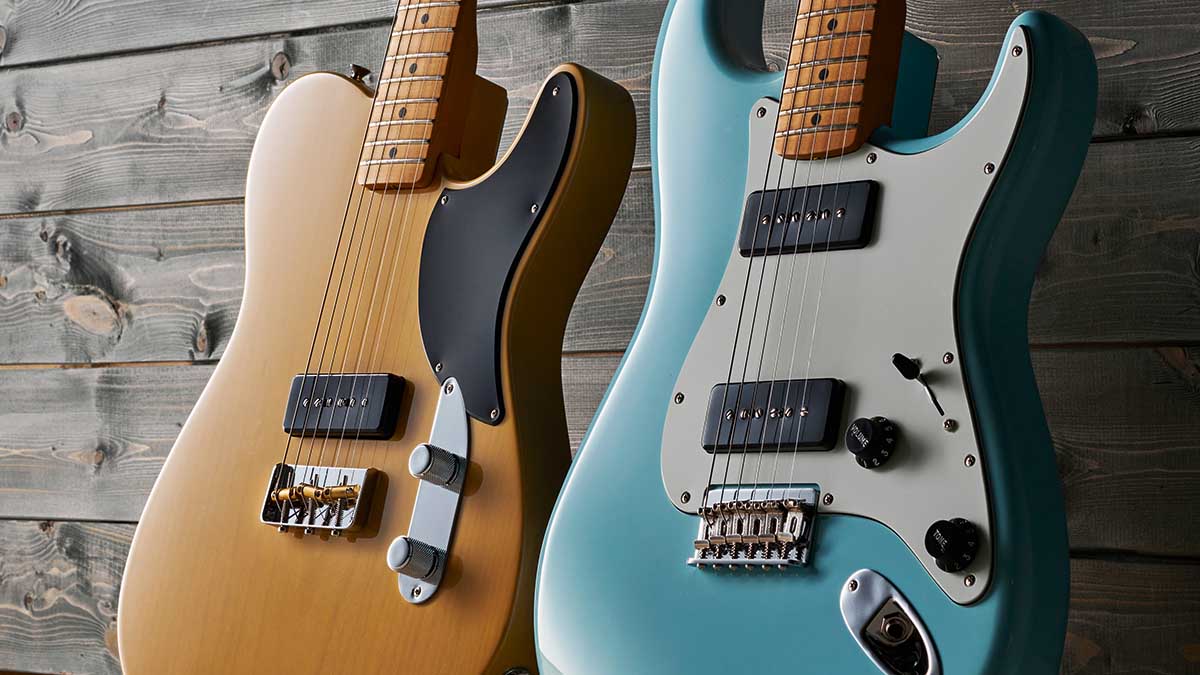Guitar World Verdict
The Tele is bonkers good with a small set of pedals into a simple amp. And if you’re not a neck-pickup person, it’s all you could ever need – especially if you’re canny with the controls. But with the superb extra tones the Strat delivers, it wins the ‘head’ decision. Whether the Tele might steal your heart, of course, we’ll leave to you.
Pros
- +
Tele is the simplest of guitars, but with great tones.
- +
Superb playability.
- +
Extremely keen price.
- +
Strat's extra tones are very persuasive.
Cons
- -
Tele might be too simple for some.
- -
Strat arguably not as happy visually as the Tele.
You can trust Guitar World
Fender continues to mine the well of potential so brilliantly presented in its most famous models. But when we saw this latest Noventa range, the sheer coolness could hardly be denied.
These guitars are made in Fender’s Mexican plant in Ensenada, with the range’s name translating as Spanish for ‘ninety’, since the guitars come equipped with P-90-style pickups.
But why would you buy a Fender guitar with a Gibson-style pickup? Well, putting a Les Paul Goldtop’s P-90 in a Telecaster isn’t going to make it sound like a Lester. There’s too much going on with the construction and materials for that to be so.
But it does make for a new and interesting sound. The simplicity of the Telecaster means it’s the perfect vehicle for all kinds of experimentation, as we’ve seen with the earlier Cabronita series.
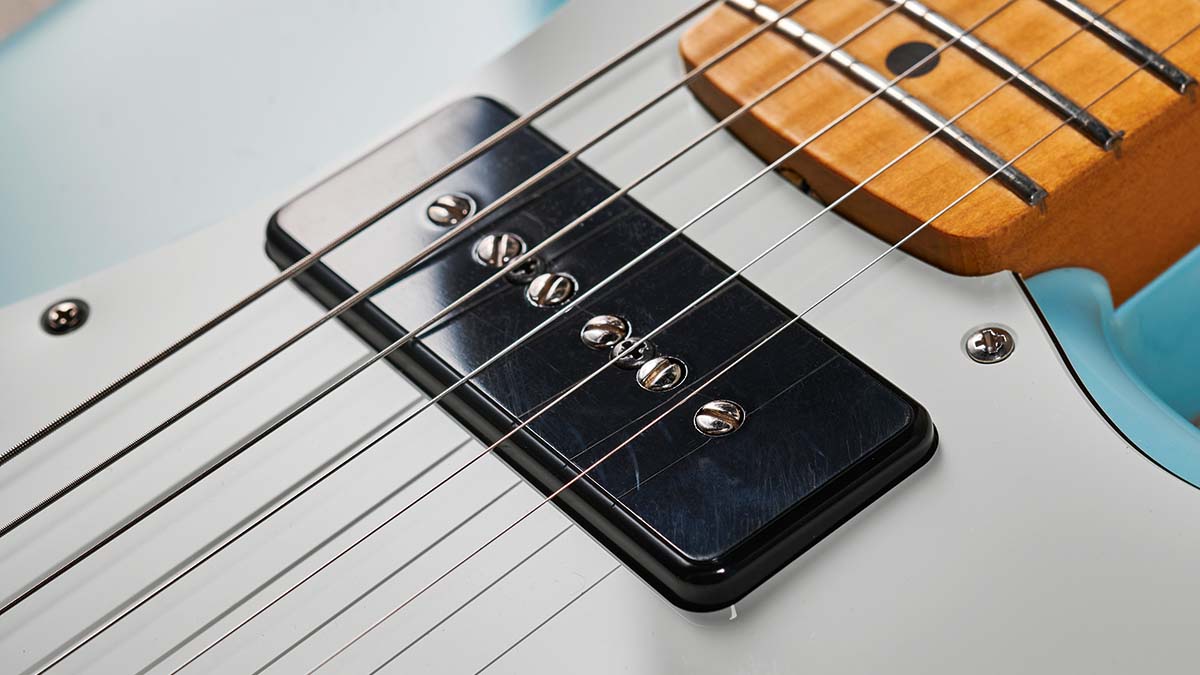
The Stratocaster, however, is a trickier proposition: its design is so perfect that you mess with it at your peril. And we feel that those large black P-90-style pickups (the neck one is a bit too big for that space) look rather, well, ‘sticky-outy’.
Cream would perhaps have been a less drastic choice aesthetically. Time will tell on that one. With our stalwart Blues Junior and a small but tasty set of pedals at the ready, let’s give the charms of both guitars the opportunity to win us over.
Noventa Telecaster
We’ve remained highly impressed by guitars built at Fender’s Ensenada facility. Fit and finish are rarely less than flawless, and they are generally playable straight out of the box. And so it is here, with the Tele’s polyester Vintage Blonde gloss as flat as glass, and buffed to a perfect finish.
All the latest guitar news, interviews, lessons, reviews, deals and more, direct to your inbox!
You couldn’t even fit the crispest, newest banknote into the neck-body gap – and you couldn’t say that for many 70s USA Fenders, which some consider ‘vintage’. Alder is the body wood, a classic Fender timber.
Deemed to give a less springy or bright sound than ash, you can clearly see its grain through the finish here. Alder Fenders with rosewood ’boards are generally believed to sound fatter than their ash and maple counterparts, so this alder P-90 maple combination could be interesting.
As mentioned, Fender has chosen maple for the Noventas’ necks, and here we see a glued-on maple fingerboard, too. This is unusual but not unheard of. A certain well-known Fender user from the 60s played a Strat with this construction at Woodstock, and this writer once owned a beautiful Sunburst ’68 Tele built this way, too.
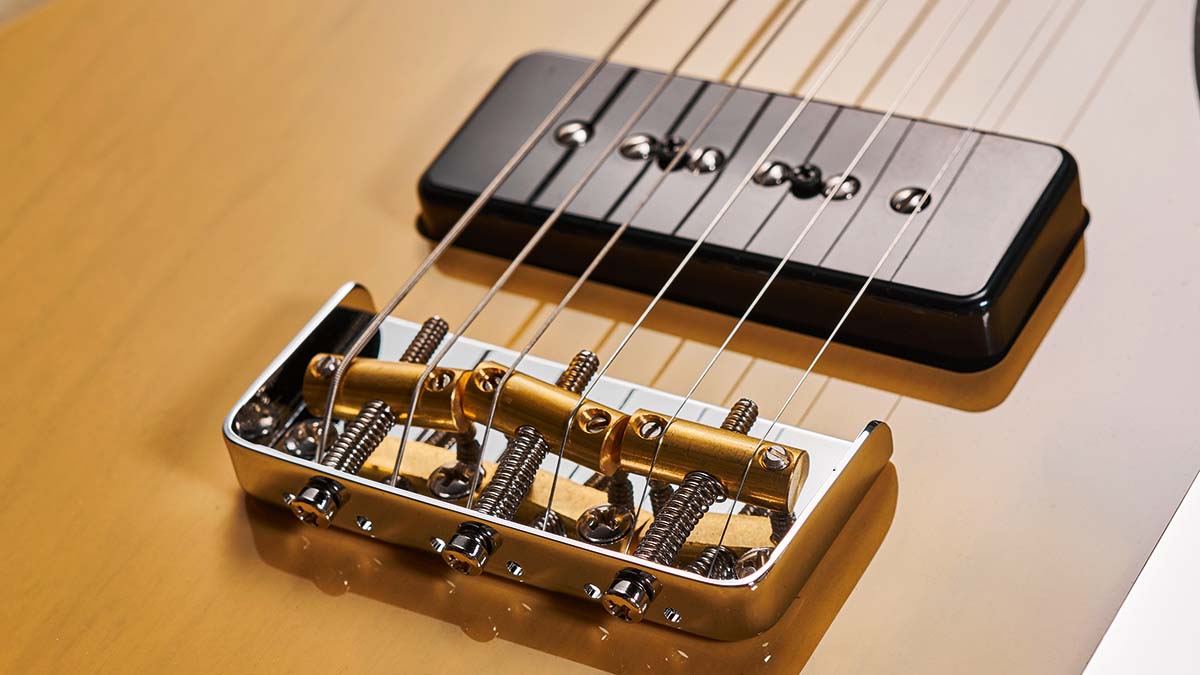
Of course, this means no walnut skunk-stripe or headstock fillet, and truss-rod adjustment is done at the body end, vintage style. This, it has to be said, is much more of a palaver than locating it at the headstock, as most modern-style Fenders do. The neck itself is finished in satin urethane, with only the headstock facing done in gloss.
Hardware-wise, we have six-a-side tuners in the classic Kluson style, a four-bolt neckplate, early P-Bass-style control plate with chromed, knurled knobs, plus a cut-down Telecaster bridge with three intonation compensated brass saddles.
This will go down well with Tele aficionados, who generally prefer the tone of brass over steel, but often complain about compromised intonation. This arrangement fixes both issues at a swipe.
As there’s no neck pickup, the ‘half’ pickguard, as Fender calls it, is very cool- looking, with its top curve in the opposite direction to that of a regular Tele ’guard. A single Noventa P-90-style pickup and single volume and tone controls are all you get with regards to electrics. But that look works so well here. In fact, overall, the Noventa’s look is a triumph of perfectly executed simplicity.
Noventa Stratocaster
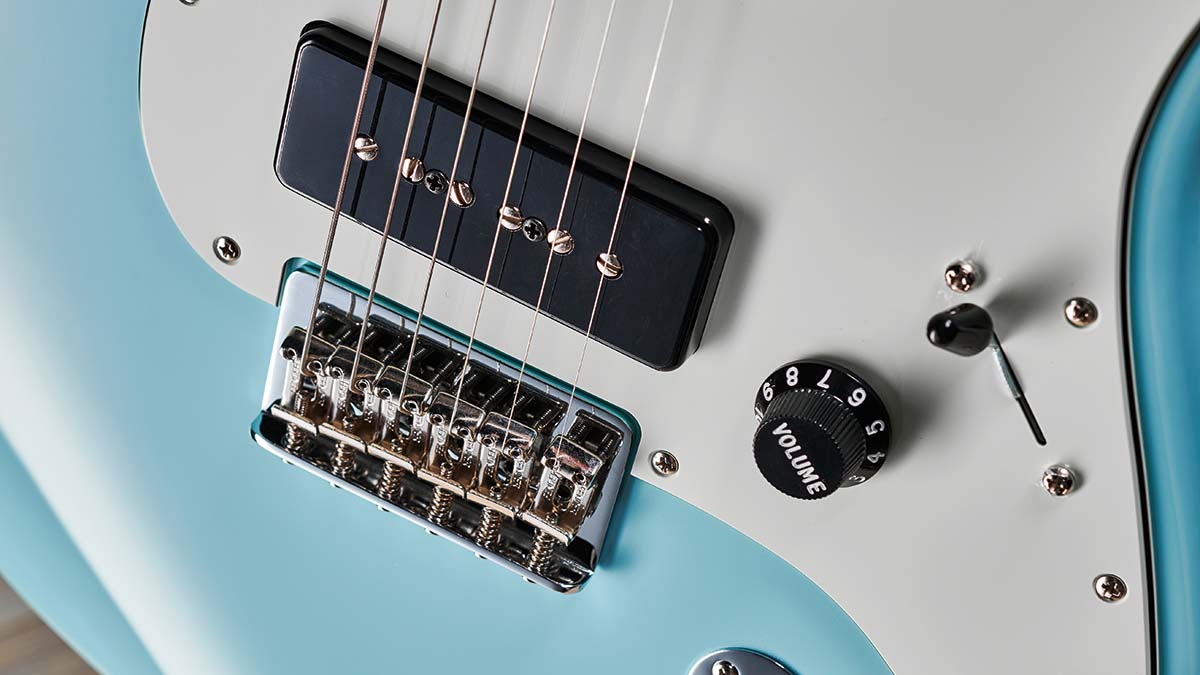
Whether it’s the overly large neck pickup compared with the slimmer, shorter regular Strat one, the fact that we’re not used to the look of a two-pickup Strat, or simply the fact that we’re not yet visually attuned to it, the Noventa Strat is not quite the happy marriage that we see in the Tele.
Of course, it’s clearly the more versatile instrument of the two, plus these are purely subjective opinions, since the next person might love this and abhor the basic-looking Tele.
Construction-wise, the two instruments have the same body and neck woods and finishes, and the glossy Daphne Blue of the Strat certainly looks smart against the translucent Vintage Blonde of the Tele. Here, the pickguard is regular three-ply mint green and black, while the bridge is the vintage hardtail style with through-body stringing and carrying half a dozen bent steel saddles.
All the other usual Strat attributes apply, such as the recessed jack and contoured body. The pair of Noventa soapbar pickups is mated to single volume and tone controls, plus a three-way switch offering neck, neck and bridge, and bridge-pickup-only options, as per a Les Paul or Telecaster. Knobs and the switch tips are black.
Feel & Sounds
You might expect, given that both guitars fall under one Noventa umbrella, that the necks would feature the same carve. Instead, the Tele has a ‘60s C’ and the Strat a ‘Modern C’ profile. While not dramatically different, the Strat’s is slightly more slender front to back, although both share the same fingerboard dimensions: 42mm at the synthetic bone nut, widening to 51mm at the 12th.
Both instruments also boast the modern 241mm fingerboard radius. Measured from behind the 1st fret, both necks come in at around 22mm, while at the 12th, it’s 24mm for the Tele and 23mm for the Strat. While the Tele has the merest hint of a ‘V’ section, the Strat is that bit flatter, but it’s the tiniest difference.
In the spec sheet, Fender states it fits Noventas with 250R 0.10-gauge strings, but these instruments feel loose and easy under the fingers, even with the 648mm (25.5-inch) scale length. In the palm, the Tele’s neck seems at one with the guitar as a whole. With its satin finish it’s so comfy, and with that slack feel it’s as smooth as syrup.
The big frets and flatter fingerboard add up to a contemporary feel on a guitar that looks to be from another era. With that millimetre 12th-fret difference and the marginally more slender feel overall, the Strat feels like an even more modern beast.
Of course, its body shape is so much more streamlined so perhaps that’s subliminally adding to the vibe. But both instruments play superbly. With the Blues Junior’s valves and transformers fully warmed up, it’s time to plug in. Tele first. Try as hard as you like and you won’t make this Noventa sound like a Telecaster.
This single-coil pickup with its considerably bigger footprint offers a different kind of twang when turned down to 6 or 7; back this off to 2 or 3 and big, open strums sound almost acoustic in nature. Full up again but still clean, it’s clear, big and bold, but pull back even a touch and it’s a bit more subtle.
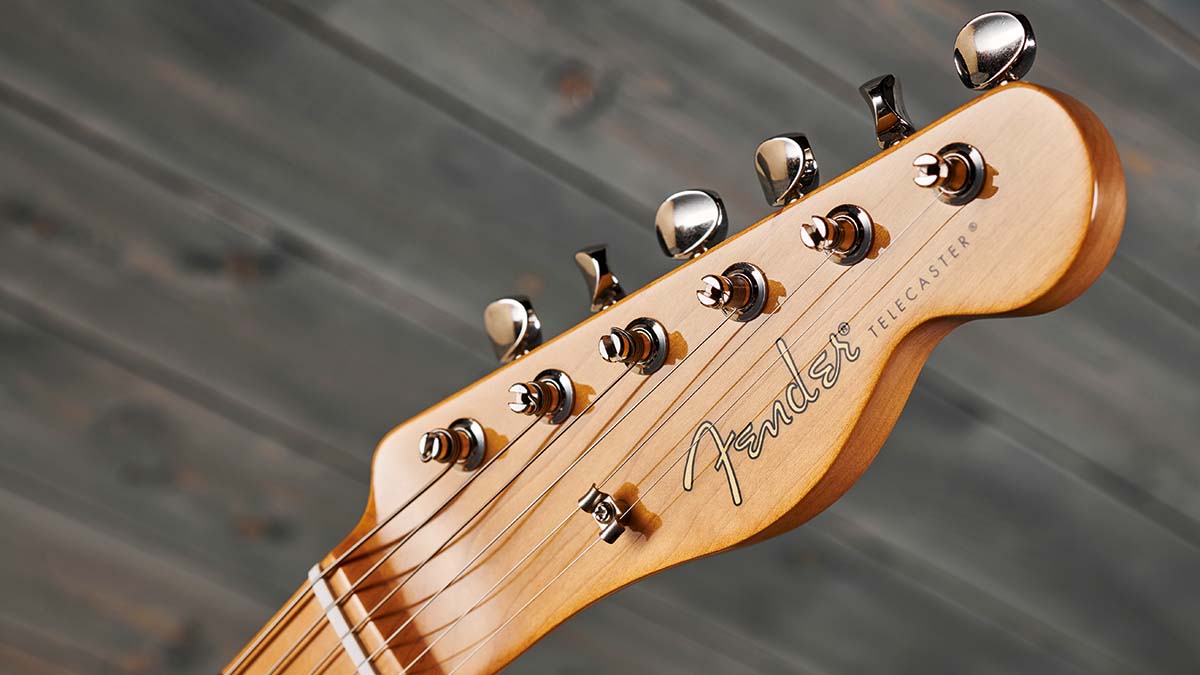
Kick in a Fulltone OCD and, good grief, it’s huge! Yes, there’s Les Paul there, but perhaps more SG as it remains highly expressive but a little less dense. Knock the tone back to 7 and we’re in our element. Add some Keeley-modded Boss DD-3 delay and it’s sonic heaven.
We’ve not had this much fun in ages. The Strat’s bridge pickup is much of a muchness, so we’ll concentrate on the neck and both units together. Keeping the Fulltone OCD on and starting at the neck, it’s so warm and musical. Yes, the old clichés such as ‘flutey’ and ‘woody’ come tripping out, but it really is that.
With no pixelation to the sound, it’s almost liquid under the fingers. Again, play with the tone controls and you’ll find ‘woman’ tone, the Money For Nothing sound and so much more. Off with the drive and a flip to middle position – rockabilly lives here. Chuck on the slapback and hours of fun are to be had.
Bring back the gain and it’s Jimmy Page and Brian May territory. Both players chose ‘honky’ sounds for certain things, and you can easily find that here. Each of these instruments is impressive. But for pure versatility the Strat wins – and one can begin to forgive that bulky neck pickup due to what it brings, musically.

Verdict
After examining and playing this pair, Fender Mexico’s excellence and consistency in build and finish added greatly to the expectation. But it was plugging in that made us realise just how good these guitars are.
The Tele is bonkers good with a small set of pedals into a simple amp. And if you’re not a neck-pickup person, it’s all you could ever need – especially if you’re canny with the controls. But with the superb extra tones the Strat delivers, it wins the ‘head’ decision. Whether the Tele might steal your heart, of course, we’ll leave to you.
Specs
Fender Noventa Series Telecaster

- PRICE: $999 / £799 (with Deluxe padded gigbag)
- ORIGIN: Ensenada, Mexico
- TYPE: Single-cutaway solidbody electric
- BODY: Solid 2-piece alder
- NECK: Maple, 4-bolt neck join, satin urethane finish with gloss urethane headstock facing
- SCALE LENGTH: 648mm (25.5”)
- NUT: Synthetic bone, 42mm
- FINGERBOARD: Glued-on maple, with black dot markers, satin urethane finish, 241 mm radius
- FRETS: 21, medium jumbo
- HARDWARE: Cut-down Telecaster bridge with through-body stringing, early P-Bass style control plate
- TUNERS: Vintage style 6-a-side, chrome/nickel plated
- STRING SPACING, BRIDGE: 55mm
- ELECTRICS: 1x Noventa soapbar pickup, single volume and tone control
- WEIGHT (KG/LB): 3.5/7.7
- OPTIONS: Pau ferro fingerboard on Sunburst version
- RANGE OPTIONS: Noventa Strat (as reviewed), Noventa Jazzmaster with 3 x Noventa pickups (£899)
- LEFT-HANDERS: Not yet available
- FINISHES: Vintage Blonde (as reviewed), Fiesta Red, Two-Tone Sunburst
Fender Noventa Series Stratocaster

- PRICE: $1,099 / £849 (with Deluxe padded gigbag)
- ORIGIN: Ensenada, Mexico
- TYPE: Double-cutaway solidbody electric
- BODY: Solid 2-piece alder
- NECK: Maple, 4-bolt neck join, satin urethane finish with gloss urethane headstock facing
- SCALE LENGTH: 648mm (25.5”)
- NUT/WIDTH: Synthetic bone, 42mm
- FINGERBOARD: Glued-on maple, with black dot markers, satin urethane finish, 241 mm radius
- FRETS: 21, medium jumbo
- HARDWARE: Hardtail Stratocaster bridge with through-body stringing, recessed jack socket
- TUNERS: Vintage style 6-a-side, chrome/nickel plated
- STRING SPACING, BRIDGE: 52mm
- ELECTRICS: 2x Noventa soapbar pickups, single volume and tone controls, 3-way selector WEIGHT (kg/lb): 3.3/7.27
- OPTIONS: Pau ferro fingerboard on Crimson Red version
- RANGE OPTIONS: Noventa Tele (as reviewed), Noventa Jazzmaster with 3x Noventa pickups (£899)
- LEFT-HANDERS: Not yet available
- FINISHES: Daphne Blue (as reviewed), Crimson Red, Surf Green
- CONTACT: Fender
In the late '70s and early '80s Neville worked for Selmer/Norlin as one of Gibson's UK guitar repairers, before joining CBS/Fender in the same role. He then moved to the fledgling Guitarist magazine as staff writer, rising to editor in 1986. He remained editor for 14 years before launching and editing Guitar Techniques magazine. Although now semi-retired he still works for both magazines. Neville has been a member of Marty Wilde's 'Wildcats' since 1983, and recorded his own album, The Blues Headlines, in 2019.
